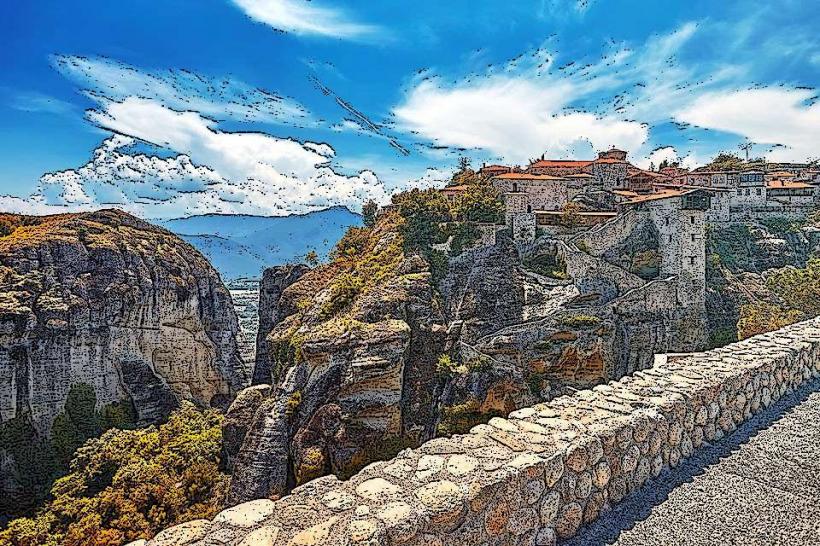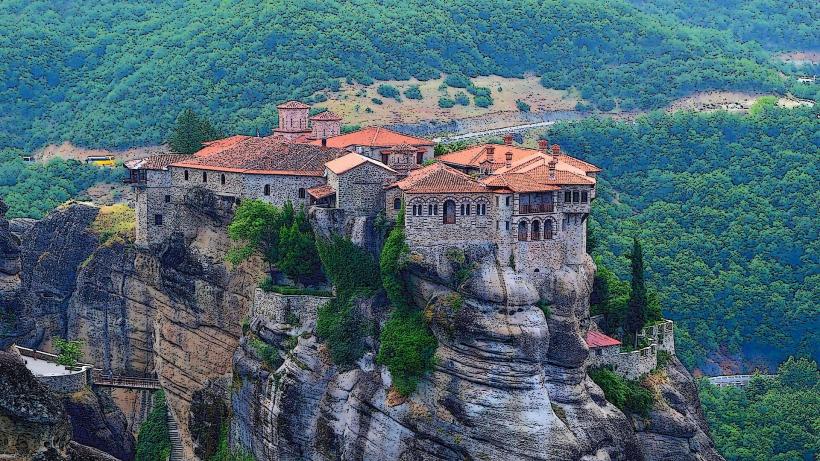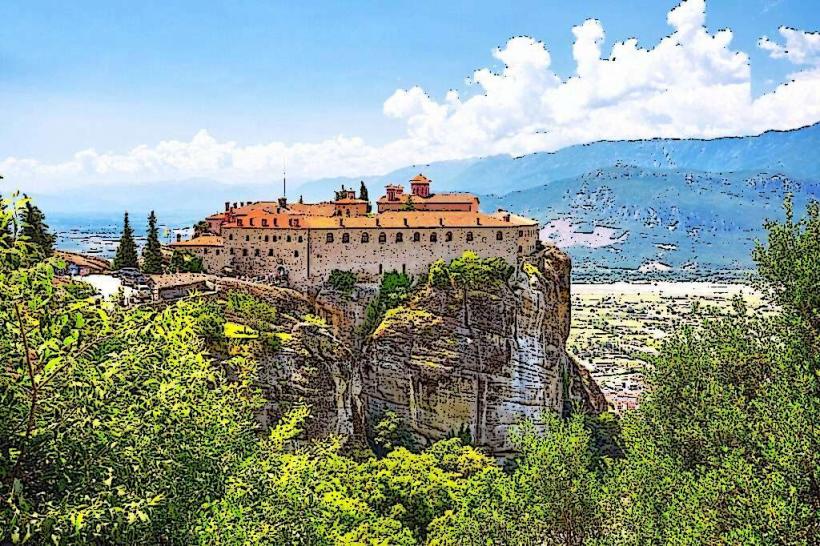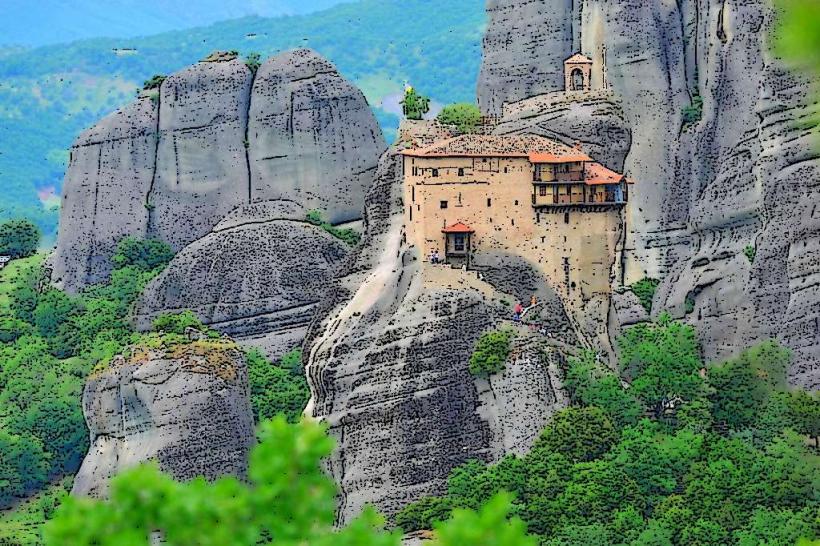Information
Landmark: Rousanou MonasteryCity: Meteora
Country: Greece
Continent: Europe
Rousanou Monastery is one of the smaller yet striking monasteries located in the Meteora region of central Greece, renowned for its unique setting and stunning views. Like the other Meteora monasteries, it is perched on one of the towering rock formations that define the Meteora landscape, offering a picturesque and tranquil environment. Rousanou Monastery is famous not only for its religious significance but also for its fascinating history and the remarkable beauty of its surroundings.
1. Historical Background
Foundation and Early History: Rousanou Monastery was likely founded in the 16th century, though its origins date back to at least the 14th century, when hermits began settling in the region. Initially, the site housed a small hermitage, and over time, it evolved into a full-fledged monastery. The founder’s identity is debated, but some sources suggest that a woman named Saint Rousanou may have played a role in its establishment, though other records attribute the founding to monks who arrived in the region seeking a secluded place for spiritual reflection.
Development: In the 16th century, the monastery was built and expanded, becoming an important center for Orthodox monasticism. Like the other Meteora monasteries, it flourished during this period, attracting monks and pilgrims from all over Greece. During this time, Greek Orthodox religious practices and Byzantine iconography became central to the monastery’s identity.
Decline: Rousanou, like many of the Meteora monasteries, experienced a period of decline during the Ottoman era, when the monks faced both external and internal challenges. The monastery, however, continued to function throughout the centuries, despite losing much of its prominence to larger monasteries in the region, such as the Great Meteoron and Varlaam Monastery.
Restoration and Revival: In the 20th century, after years of neglect, efforts to restore and preserve the monastery were undertaken. These efforts have ensured that the monastery remains intact and continues to be a place of worship and pilgrimage.
2. Architecture and Layout
Rousanou Monastery is located atop a rock pillar that rises to a height of approximately 400 meters (1,312 feet) above sea level. The monastery’s location is dramatic, offering a breathtaking view of the surrounding Meteora rock formations and the Thessalian Plain below. The monastery itself is relatively small but features typical Byzantine monastic architecture with elements of post-Byzantine influence.
Location and Accessibility: The monastery is situated on a relatively smaller rock compared to other Meteora monasteries but still commands a magnificent view of the landscape. The site can be accessed via a footbridge that connects the base of the rock to the monastery, making it accessible to visitors. The bridge was built to replace a previously existing ladder system, which was used by monks and visitors to climb the rock. Visitors today can access the monastery via a set of stairs and the footbridge.
Monastery Complex: The main buildings of the monastery are clustered around the central rock formation:
- Katholikon (Main Church): The main church of Rousanou is dedicated to the Holy Trinity. The church features Byzantine-style frescoes painted by famous Greek iconographers of the time. The frescoes depict scenes from the life of Christ, the Virgin Mary, and various saints, and are a testament to the rich religious tradition of the monastery.
- Cells and Rooms: The monastery includes a number of small monks' cells and other rooms, such as a refectory (dining area) and areas for study and prayer. These rooms are simple and functional, designed to meet the ascetic needs of the monastic community.
- Iconostasis: The iconostasis, which separates the altar from the congregation, is an impressive feature of the church. It is adorned with beautiful icons, many of which were painted in the 17th century. The iconostasis serves not only as a religious partition but also as an artistic focal point within the church.
Defensive Features: Like other Meteora monasteries, Rousanou was built with defense in mind. The natural setting provided protection from potential invaders, and the monastery's stone walls and watchtowers offered a further layer of security.
3. Frescoes and Art
Rousanou Monastery is known for its beautiful frescoes and icons, which are a key feature of its artistic heritage.
- Frescoes: The frescoes in the main church are done in the Byzantine style, with strong influences from the post-Byzantine period. The walls and ceilings of the katholikon are decorated with vibrant scenes from the life of Christ, biblical stories, and saints. These frescoes are remarkable for their vivid colors, detailed imagery, and spiritual symbolism.
- Icons: The iconostasis of the church is adorned with a series of icons painted by famous iconographers of the 17th century. These icons are highly detailed and depict key figures from Orthodox Christianity, including Christ, the Virgin Mary, and various saints.
- Sacred Objects: The monastery also houses a collection of sacred artifacts and religious objects, including manuscripts, liturgical vessels, and priests' vestments, which further enhance its religious significance.
4. Religious and Cultural Significance
- Monastic Life: Like the other Meteora monasteries, Rousanou was established as a center of monastic life, where monks dedicated themselves to prayer, asceticism, and the study of religious texts. The monks of Rousanou followed the Eastern Orthodox tradition, and the monastery played an important role in maintaining religious practices, especially during the Ottoman occupation of Greece.
- Pilgrimage Site: Over the centuries, Rousanou Monastery became an important pilgrimage site for Orthodox Christians. Visitors came to the monastery to seek spiritual solace, participate in religious services, and connect with the monastic community. Its tranquil setting and religious significance continue to attract pilgrims today.
- Greek Resistance: The monasteries of Meteora, including Rousanou, played an important role in resisting foreign domination during the Ottoman rule. The monks provided refuge to persecuted Greeks and contributed to preserving Greek culture and Orthodox Christianity during a difficult time in history.
5. Visitor Experience
- Accessibility: Rousanou Monastery is easily accessible to visitors through a series of steps and a footbridge that connects the base of the rock formation to the monastery. The bridge offers visitors the opportunity to experience the dramatic geography of the area and approach the monastery while surrounded by the majestic rock formations of Meteora.
- Monastery Grounds: Once inside the monastery, visitors can explore the church, admire the frescoes and icons, and enjoy the stunning views from the monastery’s terraces. The peaceful atmosphere of the monastery and the surrounding natural beauty make it an ideal spot for reflection and contemplation.
- Cultural Significance: Visitors can learn about the history of Rousanou Monastery through exhibits of religious artifacts, manuscripts, and liturgical items. The monastery’s small museum houses a collection of items that shed light on the daily life of the monks and the historical importance of the site.
6. UNESCO World Heritage Site
Rousanou Monastery is part of the Meteora UNESCO World Heritage Site, recognized for its extraordinary natural beauty and cultural importance. The monasteries of Meteora, including Rousanou, are among the most iconic examples of monastic architecture in the world and have been preserved as cultural treasures for future generations.
7. Today
- Active Monastery: Although the monastic community is much smaller than in the past, Rousanou Monastery remains an active place of worship. Visitors can attend services and experience the monastic life that continues to this day.
- Tourism: Rousanou, like the other Meteora monasteries, has become a major tourist destination, attracting visitors from around the world. It is one of the most accessible monasteries in the Meteora complex and is a must-visit for anyone exploring the area.
Conclusion
Rousanou Monastery, while smaller than some of the other monasteries in Meteora, is no less significant in terms of its religious and cultural heritage. Its beautiful location, remarkable frescoes, and historical importance make it a unique and essential part of the Meteora complex. Whether for its serene setting, its artistic treasures, or its deep religious significance, Rousanou continues to captivate visitors and stand as a testament to the enduring legacy of Greek monasticism.






